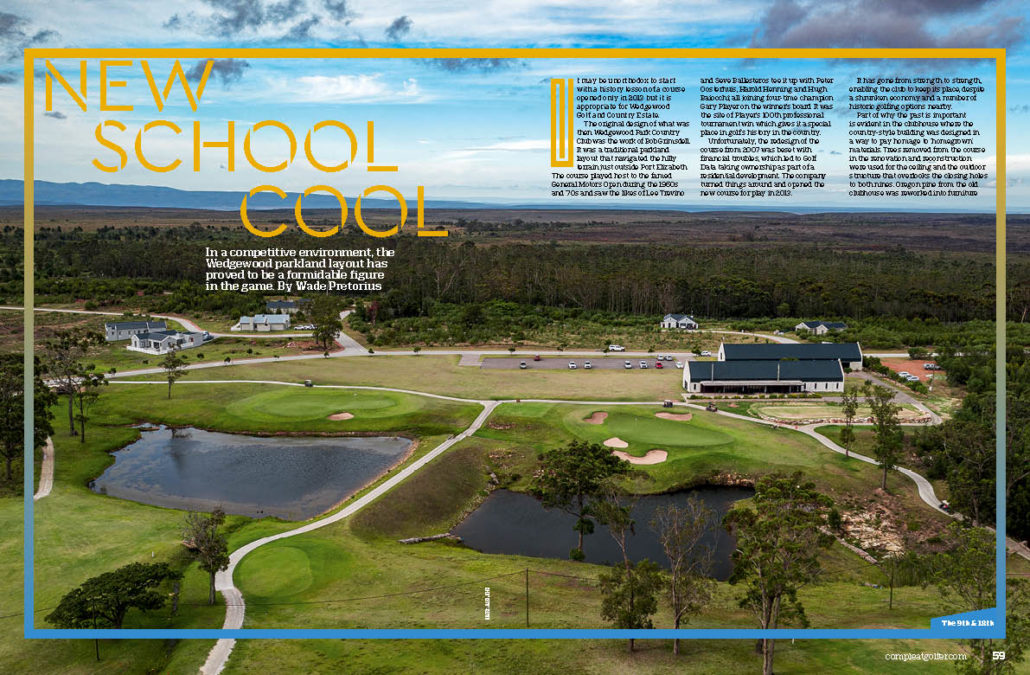In a competitive environment, Wedgewood Golf and Country Estate’s parkland layout has proved to be a formidable figure in the game, writes WADE PRETORIUS.
It may be unorthodox to start with a history lesson of a course opened only in 2013 but it is appropriate for this design.
The original design of what was then Wedgewood Park Country Club was the work of Bob Grimsdell. It was a traditional parkland layout that navigated the hilly terrain just outside Port Elizabeth. The course played host to the famed General Motors Open during the 1960s and ’70s and saw the likes of Lee Trevino and Seve Ballesteros tee it up with Peter Oosterhuis, Harold Henning and Hugh Baiocchi; all joining four-time champion Gary Player on the winner’s board. It was the site of Player’s 100th professional tournament win which gives it a special place in golf’s history in the country.
Unfortunately, the redesign of the course from 2007 was beset with financial troubles, which led to Golf Data taking ownership as part of a residential development. The company turned things around and opened the new course for play in 2013.
It has gone from strength to strength, enabling the club to keep its place, despite a shrunken economy and a number of historic golfing options nearby.
Part of why the past is important is evident in the clubhouse where the country-style building was designed in a way to pay homage to ‘homegrown’ materials. Trees removed from the course in the renovation and reconstruction were used for the ceiling and the outdoor structure that overlooks the closing holes to both nines. Oregon pine from the old clubhouse was reworked into furniture and stone from the quarry makes up part of the feature wall. The General Motors Open winner’s board sits inside the 19th hole.
Golf is supplemented by the relaxed lifestyle, far enough away from the stresses of daily life but close enough for easy access. The course is in harmony with the fauna and flora (buck and birdlife are often spotted) and it continues to attract new members from the city.
The club has worked hard on presenting a range of packages and often hosts corporate and sponsored competition days.
New to the course is the addition of dams to add to the visual appeal and difficulty factor of a layout that plays relatively short by modern standards.
The main defence, as with other coastal courses in the region, is the strong wind but the hallmark of this course is its stunning bent-grass greens. They are large, undulating and sometimes frighteningly fast. For the lower-handicap players, putting on them is a dream while the high-handicapper quickly gets to grips with course management. Leaving yourself short-sided with your approach, or worse, any length of a downhill putt and you will question your commitment when trying to find the dancefloor.
Many locals proudly declare the greens the best in the area, while the fairways have held up well in the Eastern Cape’s titanic struggle with the drought.
That said, the 1st-tee nerves are heightened with the small carry over the dam which guards the 9th and 18th holes. Danger lurks down the right as you play parallel with the 9th and only a water penalty area separates those heading out and those coming back in.
Many would agree that the outward nine is the more difficult of the two with a par-five, stroke-16, measuring nearly 500m from the club tee, as the 2nd hole. A short hole separates that and the par-five stroke-two 4th, at just under 500m, which has a water penalty area down the right, a litter of bunkers to the left and another dam short and right for those fading their long approaches into the green.
The cute par-three 7th is a real scoring opportunity, playing 139m to a generous green, before your accuracy and bravery are tested on the next two holes. The 8th is a low-stroking par four with water down the right and angles towards the slightly raised green right of tee box. A controlled fade down the left is the play before a long-iron into a wide green that runs down from top to bottom.
The closing hole is often played as a three-shot par four with a large dam guarding the front of the green. This is one of the smallest surfaces to find and is again well protected by bunkers. Only a brilliant drive will have you taking on the green where going long and hoping to see your ball run back down the steep bank is the dream.
The halfway offering is as you would expect: hearty and humble but well worth a taste. The local pies are delicious and the breakfasts may have you slowing down a little before your bid to go low on the inward nine.
The back nine is vastly different today than it was on the old track: the 15th and 16th are the only surviving holes, now being played as the 12th and 13th. The undulation is a key factor in trying to put together your round, with an iron off the
tee predominately the order of the day.
The 10th is a generous stroke seven, so avoid the hazard down the left and try to draw your tee shot into position. The next hole is one where some old-school course management is needed to resist the urge to draw the green by taking the ‘Tiger-line’ down the right over the trees. With the fairway sloping sharply to the left towards the greenside bunker, this is another iron tee shot for position.
The 12th is a wonderful par three played over a large dam to the green below the tee box and protected by bunkers left and long as well as short and right. The ball always comes back down the steep embankment so make sure you have enough club. Missing left or right will leave you with a mad scramble for par on a tough green, regardless of the pin position.
The 14th is the next par three, played up to a green which is wider than most. Club up and swing confidently for there is bush ready to welcome anything left short. The par-five 15th is short at just over 430m, so the trick here is to find the fairway down the right and then avoid the trees that narrow the landing area of your approach shot. The back-left bunker is to be avoided at all costs as the green runs sharply back to front.
The stroke-one 16th follows but it isn’t the toughest test on the course with length its main defence. The greenkeeper enjoys the back-right flag position which punishes any overeager approach. Take your par and walk on to the next box satisfied.
The closing par five is a matchplay golfer’s delight with a good drive setting up a mid-iron approach into the green. If you are out of position, a lay-up to the 100m marker is advised, before playing down to the large green. It may look welcoming from the fairway but you’ll have your nerves tested if you attempt to find the green in two and avoid the scattering of bunkers that make this a ‘harder than it looks par five’.
Any score from eagle to double-bogey is in play here, so be sure to see out your game in confident fashion.
Most golf courses, particularly the greens, take time to settle and Wedgewood’s offering has passed the test. The design is fun to play and most skill levels can still enjoy the round even if the wind picks up. Pay a visit for the atmosphere and return for another putting masterclass.







